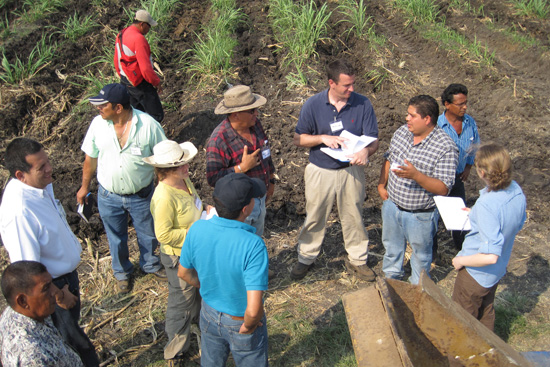Tracking a Public Health Mystery in Nicaragua
SPH researchers investigate disease killing thousands

Nicaragua has a compelling public health mystery: thousands of people in the northwestern part of the country are dying from chronic kidney failure, and no one knows why.
An interdepartmental team of School of Public Health researchers is on the case, sifting for answers.
“The disease has, essentially, been a death sentence once you get it,” says group leader Daniel Brooks, an SPH associate professor of epidemiology. “We don’t often have public health epidemics where we really have no idea what the cause is. In this case, that is the situation.”
Since 2009, Brooks and his BU team have been investigating why residents of two regions of Nicaragua—Chinandega and Leon—are contracting chronic kidney disease at a rate more than 10 times that of people in the United States. Under the auspices of the World Bank’s Office of the Compliance Advisor/Ombudsman (CAO), the team has developed a strategy to probe possible reasons for the epidemic and is conducting a wide-ranging study to try to pinpoint causes.
The scientists are working with a few clues that they hope may lead them to answers. Previous studies indicate that deaths are more common among men than women and that the disease is striking people as young as 20 or 30 years old.
Among those with the disease are a large number of former agricultural workers at a sugarcane plantation owned by the area’s largest employer, Nicaragua Sugar Estates Limited (NSEL). A number of former employees formed a group, alleging that NSEL was exposing workers to something that was causing the epidemic—a claim disputed by the company. The group lodged a complaint in 2008 with the CAO. Two years earlier, a branch of the World Bank had provided a $55 million loan to the sugarcane operation.
In response to the complaint, the CAO brought together workers and company management to try to find answers, with the BU team retained to develop a strategy for studying possible causes.
To date, the SPH team has done several studies, ranging from the work processes used at NSEL to the agrichemicals used on crops to screening water samples for contaminants known to cause chronic kidney disease. Nothing so far has been able to explain the high occurrence of the disease.
The research team and other stakeholders spoke of their challenges and progress at a recent Medical Campus forum, An Epidemic of Chronic Kidney Disease in Nicaragua: BUSPH Responds to a Public Health Crisis. Attending were Nicaraguan health professional Juan Jose Amador, who is working in the affected community; CAO representative Amar Inamdar, who is overseeing the conflict between the Nicaraguan sugarcane company and the organization of former workers; and conflict management expert Juan Dumas, who is mediating the complex dialogue process that is central to the epidemic’s study.
“Nicaragua Sugar Estates Limited may be conducting itself in accordance with work practices that we say are okay,” said Inamdar. “But does that tell you why or how kidney disease is happening among a good 30 percent of the workforce? No.”
“People have been looking for an answer for a number of years, and they haven’t found one,” said Brooks. “There have been various theories, from heat to infectious disease to toxin exposure. It’s very much still a mystery.”
SPH researchers have been joined in the project by specialists from the BU School of Medicine, the Massachusetts Department of Public Health, the Tufts University School of Medicine, and the Universidad Autonoma de Madrid.
While the main goal of the researchers is to identify causes and end the epidemic, Brooks said, the study process itself has fostered important advances, including a growing trust and collaboration among the various stakeholders involved.
“How do we make them work as a group to fight chronic kidney disease?” said Dumas. “I believe that is our main challenge. This is about people cooperating.”
The researchers plan to continue testing sugarcane workers, interviewing local physicians, and examining other possible occupational and nonoccupational exposures in an effort to unlock the mystery.
For his part, Brooks, whose regular areas of research center on tobacco-related disease and cancer epidemiology, said he is hopeful that the combined skills of epidemiologists, environmental health professionals, renal disease specialists, and global health scholars eventually will lead to answers.
“This may be the most challenging, but also the most meaningful, work I’ve undertaken,” he said. “It’s not often that we have a chance to do work that could have such a profound and direct impact on people’s lives.”
Lisa Chedekel can be reached at chedekel@bu.edu. Elana Zak can be reached at ezak@bu.edu.
Comments & Discussion
Boston University moderates comments to facilitate an informed, substantive, civil conversation. Abusive, profane, self-promotional, misleading, incoherent or off-topic comments will be rejected. Moderators are staffed during regular business hours (EST) and can only accept comments written in English. Statistics or facts must include a citation or a link to the citation.